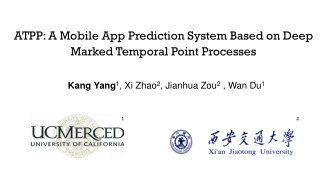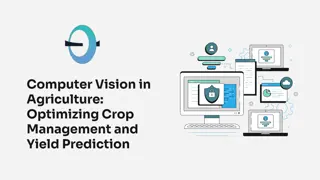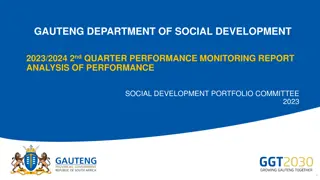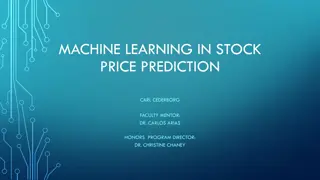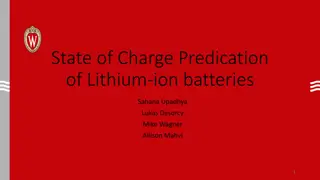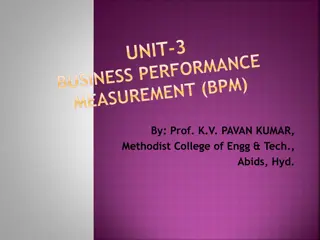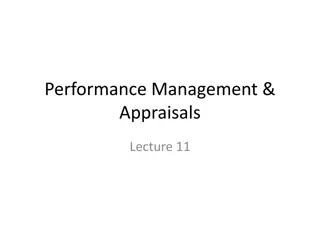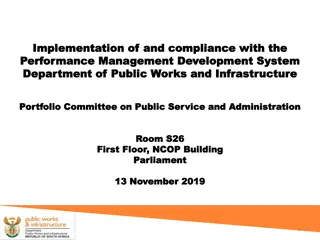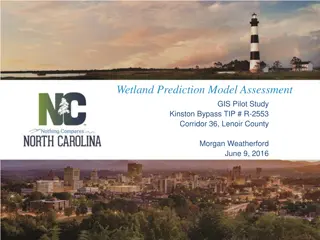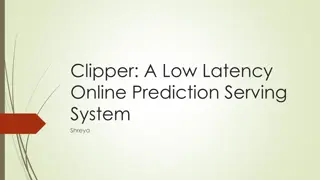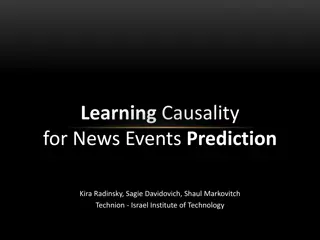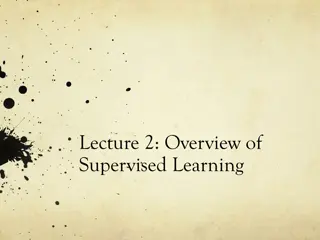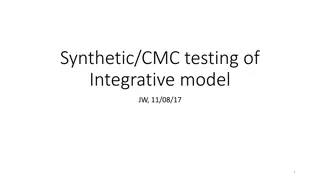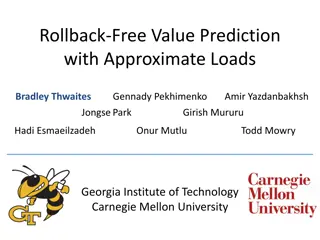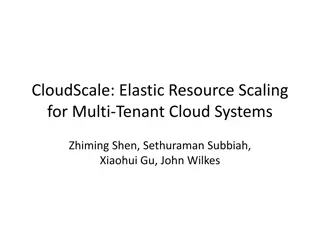Deep Reinforcement Learning for Mobile App Prediction
This research focuses on a system, known as ATPP, based on deep marked temporal point processes, designed for predicting mobile app usage patterns. By leveraging deep reinforcement learning frameworks and context-aware modules, the system aims to predict the next app a user will open, along with its
0 views • 24 slides
Address Prediction and Recovery in EECS 470 Lecture Winter 2024
Explore the concepts of address prediction, recovery, and interrupt recovery in EECS 470 lecture featuring slides developed by prominent professors. Topics include branch predictors, limitations of Tomasulo's Algorithm, various prediction schemes, branch history tables, and more. Dive into bimodal,
0 views • 42 slides
Understanding H.264/AVC: Key Concepts and Features
Exploring the fundamentals of MPEG-4 Part 10, also known as H.264/AVC, this overview delves into the codec flow, macroblocks, slices, profiles, reference picture management, inter prediction techniques, motion vector compensation, and intra prediction methods used in this advanced video compression
2 views • 32 slides
Computer Vision in Agriculture: Optimizing Crop Management and Yield Prediction
In recent years, the agriculture industry has witnessed a significant transformation fueled by technological advancements. Among these innovations, computer vision has emerged as a game-changer, offering unparalleled opportunities to optimize crop management and enhance yield prediction. Leveraging
7 views • 19 slides
Gauteng Department of Social Development 2nd Quarter Performance Analysis 2023/2024
Analyzing the 2nd quarter performance monitoring report of the Gauteng Department of Social Development for 2023/2024 reveals insights into program performance, governance, financial status, and rating categories. The report delves into departmental overview, non-financial performance, and areas of
0 views • 70 slides
Understanding Machine Learning for Stock Price Prediction
Explore the world of machine learning in stock price prediction, covering algorithms, neural networks, LSTM techniques, decision trees, ensemble learning, gradient boosting, and insightful results. Discover how machine learning minimizes cost functions and supports various learning paradigms for cla
2 views • 8 slides
Advancements in Air Pollution Prediction Models for Urban Centers
Efficient air pollution monitoring and prediction models are essential due to the increasing urbanization trend. This research aims to develop novel attention-based long-short term memory models for accurate air pollution prediction. By leveraging machine learning and deep learning approaches, the s
0 views • 17 slides
Understanding State of Charge Prediction in Lithium-ion Batteries
Explore the significance of State of Charge (SOC) prediction in lithium-ion batteries, focusing on battery degradation models, voltage characteristics, accurate SOC estimation, SOC prediction methodologies, and testing equipment like Digatron Lithium Cell Tester. The content delves into SOC manageme
0 views • 32 slides
Overview of Performance Management Systems and Competency Mapping
Performance Management Systems (PMS) play a crucial role in ensuring organizational objectives are met through individual contributions. This entails continuous improvement at all levels - individual, team, and organizational. Managing performance is vital for survival and growth in a competitive en
3 views • 45 slides
KFRE: Validated Risk Prediction Tool for Kidney Replacement Therapy
KFRE, a validated risk prediction tool, aids in predicting the need for kidney replacement therapy in adults with chronic kidney disease. Developed in Canada in 2011, KFRE has undergone validation in over 30 countries, showing superior clinical accuracy in KRT prediction. Caution is advised when usi
0 views • 9 slides
Real-time Experimental Lightning Flash Prediction Report
This Real-time Experimental Lightning Flash Prediction Report presents a detailed analysis of lightning flash forecasts based on initial conditions. Prepared by a team at the Indian Institute of Tropical Meteorology, Ministry of Earth Sciences, India, the report includes data on accumulated total li
0 views • 6 slides
Quarterly Performance Report Presentation to Portfolio Committee
This report presents the performance of the Department for the 1st, 2nd, and 3rd quarters to the Portfolio Committee on Public Works and Infrastructure. It includes non-financial and financial performance details, color coding guide, target achievements, performance averages, management performance
0 views • 43 slides
Privacy-Preserving Prediction and Learning in Machine Learning Research
Explore the concepts of privacy-preserving prediction and learning in machine learning research, including differential privacy, trade-offs, prediction APIs, membership inference attacks, label aggregation, classification via aggregation, and prediction stability. The content delves into the challen
0 views • 11 slides
Understanding Business Performance Measurement (BPM) and Essential Elements
Business Performance Measurement (BPM) refers to the processes used by organizations to assess their performance and achieve set goals. It involves employing tools, techniques, methodologies, and metrics to monitor and manage business performance. Performance measures help evaluate progress, goal ac
6 views • 57 slides
Understanding Performance Management and Appraisals in the Workplace
Performance management and appraisals are crucial processes for evaluating employees' performance, setting work standards, providing feedback, and facilitating career planning. This involves assessing employees' performance relative to set standards, identifying training needs, and aligning individu
12 views • 23 slides
Implementation of Performance Management Development System at Department of Public Works and Infrastructure
Briefing the Portfolio Committee on Public Service and Administration on the implementation and compliance with the Performance Management Development System (PMDS) within the Department of Public Works and Infrastructure. The content covers aspects such as signing of performance agreements, PMDS pl
1 views • 20 slides
Enhancing Web Search Latency with DDS Prediction
This presentation delves into DDS Prediction, a technique designed to reduce extreme tail latency in web search engines by optimizing query execution times and parallelizing specific queries. It addresses the challenges of improving latency for all users and emphasizes the importance of achieving hi
0 views • 31 slides
Wetland Prediction Model Assessment in GIS Pilot Study for Kinston Bypass
Wetland Prediction Model Assessment was conducted in a GIS pilot study for the Kinston Bypass project in Lenoir County. The goal was to streamline project delivery through GIS resources. The study focused on Corridor 36, assessing various wetland types over a vast area using statistical and spatial
0 views • 16 slides
Clipper: A Low Latency Online Prediction Serving System
Machine learning often requires real-time, accurate, and robust predictions under heavy query loads. However, many existing frameworks are more focused on model training than deployment. Clipper is an online prediction system with a modular architecture that addresses concerns such as latency, throu
0 views • 17 slides
Address-first Value-next Predictor with Value Prefetching
Improving single-thread performance in modern processors efficiently is crucial. AVPP proposes optimizations to reduce hardware cost for load value prediction, introducing a new taxonomy of Value Prediction Policies. AVPP outperforms state-of-the-art predictors, providing system performance improvem
0 views • 49 slides
Theoretical Justification of Popular Link Prediction Heuristics
This content discusses the theoretical justification of popular link prediction heuristics such as predicting connections between nodes based on common neighbors, shortest paths, and weights assigned to low-degree common neighbors. It also explores link prediction generative models and previous empi
0 views • 39 slides
Using Decision Trees for Program-Based Static Branch Prediction
This presentation discusses the use of decision trees to enhance program-based static branch prediction, focusing on improving the Ball and Larus heuristics. It covers the importance of static branch prediction, motivation behind the research, goals of the study, and background on Ball and Larus heu
0 views • 36 slides
Unveiling the Black Box: ML Prediction Serving Systems
Delve into the world of Machine Learning Prediction Serving Systems with a focus on low latency, high throughput, and minimal resource usage. Explore state-of-the-art models like Clipper and TF Serving, and learn how models can be optimized for performance. Discover the inner workings of models thro
0 views • 30 slides
Understanding Causality in News Event Prediction
Learning about the significance of predictions in news events and the process of causality mining for accurate forecasting. The research delves into problem definition, solution representation, algorithms, and evaluation in event prediction. Emphasis is placed on events, time representation, predict
0 views • 36 slides
Overview of Supervised Learning in Regression and Classification
Dive into the fundamental concepts of supervised learning through regression and classification methods. Explore the differences between regression and classification, understand input vectors, terminology of variables, performance evaluation criteria, and optimal prediction procedures. Discover the
0 views • 45 slides
Overview of Synthetic Models in Transcriptional Data Analysis
This content showcases various synthetic models for analyzing transcriptome data, including integrative models, trait prediction, and deep Boltzmann machines. It explores the generation of synthetic transcriptome data and the training processes involved in these models. The use of Restricted Boltzma
0 views • 14 slides
Network Coordinate-based Web Service Positioning Framework for Response Time Prediction
This paper presents the WSP framework, a network coordinate-based approach for predicting response times in web services. It explores the motivation behind web service composition, quality-of-service evaluation, and the challenges of QoS prediction. The WSP framework enables the selection of web ser
0 views • 30 slides
Understanding Peer Prediction Mechanisms in Learning Agents
Peer prediction mechanisms play a crucial role in soliciting high-quality information from human agents. This study explores the importance of peer prediction, the mechanisms involved in incentivizing truthful reporting, and the convergence of learning agents to truthful strategies. The Correlated A
0 views • 7 slides
Enhancing Processor Performance Through Rollback-Free Value Prediction
Mitigating memory and bandwidth walls, this research extends rollback-free value prediction to GPUs, achieving up to 2x improvement in energy and performance while maintaining 10% quality degradation. Utilizing microarchitecturally-triggered approximation to predict missed loads, this work focuses o
0 views • 7 slides
Enhancing Wind Turbine Performance Through PCWG Activities
The PCWG (Performance Characterization Working Group) aims to improve real-world wind turbine performance prediction beyond the simple Power=P(v) equation. By introducing concepts like Inner-Outer Range Decomposition and Average-Specific Decomposition, the group addresses factors such as environment
0 views • 13 slides
PhD in Telematics Engineering: Traffic Prediction with Big Data Technologies
This PhD study focuses on traffic prediction using Big Data technologies within Software-Defined Networking (SDN). It explores the separation of data and control planes in SDN architectures, emphasizing the benefits of centralized control for network operations. Additionally, the study delves into t
0 views • 33 slides
CloudScale: Elastic Resource Scaling for Multi-Tenant Cloud Systems
CloudScale is an automatic resource scaling system designed to meet Service Level Objective (SLO) requirements with minimal resource and energy cost. The architecture involves resource demand prediction, host prediction, error correction, virtual machine scaling, and conflict handling. Module 1 focu
0 views • 37 slides
Amendments to WIPPS Manual for Climate Prediction at INFCOM-3, April 2024
The document discusses amendments to the Manual on WIPPS for climate prediction, including new recommendations for weather, climate, water, and environmental prediction activities. It introduces concepts such as Global Climate Reanalysis and the coordination of multi-model ensembles for sub-seasonal
0 views • 10 slides
Protein Secondary Structure Prediction: Insights and Methods
Accurate prediction of protein secondary structure is crucial for understanding tertiary structure, predicting protein function, and classification. This prediction involves identifying key elements like alpha helices, beta sheets, turns, and loops. Various methods such as manual assignment by cryst
0 views • 30 slides
ACE RAM Workshop - Barcelona 2019: Reliability and Maintenance Concepts
The ACE RAM Workshop conducted by George Pruteanu in Barcelona focused on topics such as RAM prediction, FMEA, maintenance concepts, preventive and predictive maintenance, condition monitoring systems, corrective maintenance, and design for maintenance. The workshop delved into reliability predictio
0 views • 16 slides
Enhancing TLB Architecture with CoPTA for Improved Performance
CoPTA introduces a novel TLB architecture with contiguous pattern speculating capabilities to optimize address translation, especially for big-data workloads. By modifying TLB and LSQ to support TLB speculation, performance improvements in memory contiguity and prediction accuracy were achieved. The
0 views • 6 slides
Radiomic Feature Assessment Through Downsampling Strategy
Radiomics involves extracting quantitative features from medical images to help in diagnosis, treatment response prediction, and prognosis. However, a recurrent problem in radiomics is the lack of satisfying classification or prediction models due to insufficient data or irrelevant information. To a
0 views • 16 slides
Clock-Aware UltraScale FPGA Placement with Machine Learning Routability Prediction
The research focuses on addressing the challenges of clock constraints, routability, and wirelength in UltraScale FPGAs. Various placement techniques are introduced, such as two-step displacement-driven legalization and chain move, to optimize performance. The study incorporates different routabilit
0 views • 31 slides
Analysis and Comparison of Wave Equation Prediction for Propagating Waves
Initial analysis and comparison of the wave equation and asymptotic prediction of a receiver experiment at depth for one-way propagating waves. The study examines the amplitude and information derived from a wave equation migration algorithm and its asymptotic form. The focus is on the prediction of
0 views • 23 slides
Evaluation of Clinical Prediction Models Using Net Benefit versus ROC Curves
Performance evaluation of clinical prediction models involves comparing predicted outcomes with ground truth data using ROC curves. The area under the ROC curve (AUC) is commonly used to assess model performance. A novel method for comparing different models is proposed. Decision-making on treatment
0 views • 22 slides
